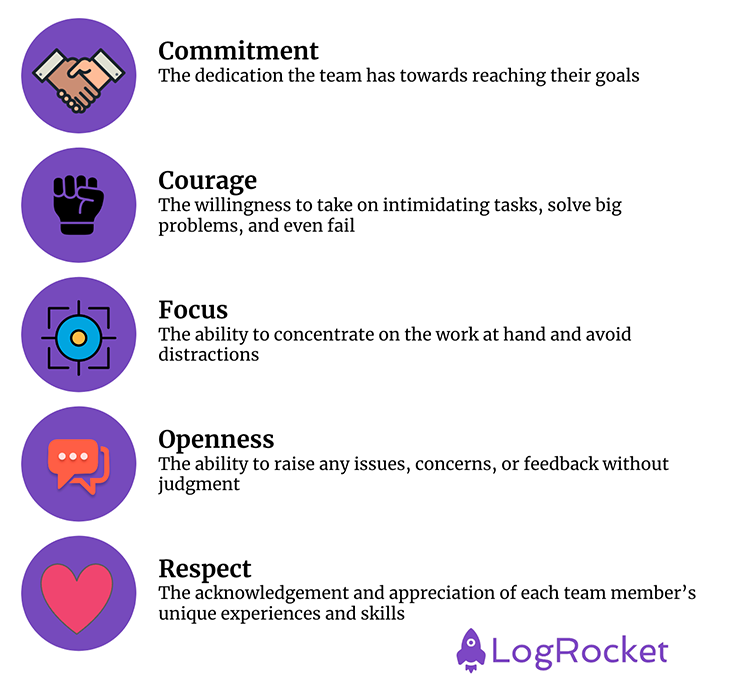Many organizations implement scrum to run their product and project management functions. What many people enjoy about scrum is that, though it has specific practices that need to be followed, it’s flexible enough to adapt to the needs of any organization.

Scrum’s practices and rules may seem intimidating to many; there are five scrum values, three pillars, three scrum team roles, five events or ceremonies, and three artifacts. It seems like a lot to memorize! Believe it or not, they lay a great foundation and they make sense when you think about it.
Roles and ceremonies aside, this article will focus on the five scrum values and their meanings: commitment, courage, focus, openness, and respect. Let’s jump in.
The purpose of the five scrum values is to give direction to the scrum team around how they go about their work and interact with their teammates.
The scrum values are like standards or principles, if you will, that scrum team members should keep in mind as they go about their work. Upholding the scrum values makes for a productive, collaborative, and cohesive team that is committed to the work and works well together.
The five scrum values are commitment, courage, focus, openness, and respect:

So now that we know what the scrum values are, let’s look into each of them and learn what they are, what they mean, and how they can be applied on a scrum team:
The first scrum value is commitment. This refers specifically to the dedication the team has towards reaching their goals. Though it seems pretty obvious, commitment is important as it ensures that the team is trying their best to deliver a releasable increment at the end of each sprint.
For example, let’s say a team is working on a sprint to deliver a new feature for their e-commerce product. The feature is going to incorporate wishlists so that users can add items they’re interested in to a list they create. In this case, commitment means that each scrum team member is dedicating their time and skill sets towards creating this list feature, allowing it to be renamed and customized, and making sure that items can successfully be added to each list. Everyone is working hard towards the same goal, and that is commitment.
Having engaged, active, committed team members is not as easy as it seems. People get burnt out sometimes and teams can lose focus of their end goal. One way leaders can help enforce the commitment value is by promoting ownership. Team members can pick tasks from the backlog that they’re most interested in to help them work on things they like and are committed to bringing to fruition.
The next scrum value is courage. You may be thinking of the lion from The Wizard of Oz (I mean, that was my first thought too), but courage here means the willingness to take on big, intimidating tasks. Encompassing the courage value means that teams aren’t afraid of failure and accept that it’s a possibility.
Think about a time when you were halfway through a project or task and realized you’d been doing it wrong the whole time. If you were working on a scrum team and this happened, an example of demonstrating courage would be bringing up the issue, owning up to it, and figuring out a way to fix it. It could imply starting over or changing course even though it may be challenging and require extra effort.
Promoting courage is important, especially when employees have a high standard for themselves. One way to encourage courage (ha, get it?) is by creating an environment where taking risks is a good thing and failures aren’t held against you. In fact, failures should be looked at as opportunities for learning, not as setbacks.
As someone who is lucky enough to work in a very supportive environment, it makes a big difference knowing that I won’t be looked down upon or penalized for making mistakes. In fact, it encourages me to step outside of my comfort zone and try new things. As a result, holding this scrum value and successfully implementing it can be the difference between good and great.
Focus is similar to commitment but not quite the same. Focus, in scrum, refers to the team’s ability to block out distractions and put their heads down into their work. It means maximizing efficiency and productivity without straying away from the tasks at hand.
For example, think of a team member who is working on improving a feature in the current sprint. While working on it, they notice that the UI on one page doesn’t look consistent with the others. Focus would mean that the team member continues to work on the task at hand and saves that UI work for another time, flagging it to be added to the backlog but not immediately working on it right now.
Let’s be real — it’s super easy to get distracted. To enforce focus, it’s helpful to promote work management techniques, like time boxing, and eliminate unnecessary meetings that can disrupt the flow of work. Also, encourage team members to block off “focus times” on their calendars or via Slack status where they would prefer not to be disturbed.
The penultimate scrum value is openness. Openness builds nicely off of courage and promotes the ability to raise any issues, concerns, or feedback without judgment. Team members who accept and implement openness should be willing to take criticism (both positive and constructive), try new ideas, hear their teammates out, and share any concerns they have.
The best way to implement this is to build a trusting environment. Not getting angry at team members for raising concerns and welcoming constructive criticism without taking it personally are key here. Team members should trust each other to be honest.
A good example of this is regarding time management. Say a team member is struggling to finish their task. In some environments, it might be easy to put their head down and scramble to get it done without anyone knowing. In an environment where the openness scrum value is adopted, they can be honest with the team and ask for a hand. This will ultimately keep everyone in the loop and prevent any team members from feeling overwhelmed.
Because openness encompasses many angles, let’s give one more example. Say a teammate noticed that another, more junior team member, took an approach that’s not the most effective. It may lead to issues down the line if they want to develop that work further. Despite how uncomfortable the conversation may be, the value of openness encourages the first teammate to voice their concerns. They openly, yet respectfully, bring up the issue, explain their reasoning, and propose an alternate solution.
Both examples highlight what openness is all about: constructive criticism and new ideas in the face of uncomfortable conversations, even when the conversation could have been uncomfortable. At the end of the day, this is going to help product quality and build trust within the team.
The final of the five scrum values is respect. This is (hopefully) what we’ve all been taught since kindergarten: everyone has the right to be heard and appreciated. Respect acknowledges and appreciates all team members and their unique experiences and skills. Everyone’s voice is valued and nobody is more important than another.
One common example of the respect value is in team meetings. It’s easy for one or two voices to overpower the rest — this may just be due to personality or comfort levels. To practice the respect value, ensure everyone has an opportunity to voice their opinions and inputs during meetings.
As we just learned, applying the five scrum values — commitment, courage, focus, openness, and respect — is heavily weighted toward the team itself. But it’s also important to apply the scrum values as guiding principles that shape your everyday actions and decisions.
Commitment is shown through your dedication to the product vision. Are you committed to making sure you’re delivering exactly what customers want and need? Commitment is about being all-in to understanding your customers, what they’re looking for, why your product is different from the rest, and how you can continue to improve it.
Courage is how willing you are to step out of your comfort zone. There may be times when you don’t know the right answer or what you’re looking for, but that’s okay — taking leaps and making informed decisions is the best way forward. Through tough macro environments, failures, or uncertainties, you can embody courage by taking risks and accepting that failures happen. Learning from your mistakes will only make you stronger.
You can apply the focus scrum value by always thinking of that light at the end of the tunnel — your end goal. Though so many things can come up in a day, focus is about pushing through distractions and working on the tasks in front of you. Managing your meetings, blocking time off your calendar for your own work, and setting expectations around your tasks will all help you stay focused.
Being open is hard, especially when it means you have to be vulnerable and own up to your mistakes. Once you start doing this, you’ll encourage those around you to do the same. Being transparent and creating a space where others around you feel psychologically safe is one of the most rewarding things you can do. Encourage feedback and be open to change based on what you hear.
Respect is fundamental. How you treat your teammates, colleagues, customers, and clients says a lot about you and the organization you work for. Make sure that others know their opinions and ideas are welcome, even if you don’t end up choosing to move forward with them. Further, make sure that you’re hearing everyone out equally and not favoring any voices over others.
The five scrum values are commitment, courage, focus, openness, and respect. Practicing these values doesn’t mean merely checking each one off a list, but letting them build and flow off of each other every day. With the combination of these values, you’ll be able to create a motivated, high-performing scrum team that delivers awesome results.
If you have any specific tips or examples of these scrum values, I’d love to hear them in the comments below. Thank you for reading!
Featured image source: IconScout

LogRocket identifies friction points in the user experience so you can make informed decisions about product and design changes that must happen to hit your goals.
With LogRocket, you can understand the scope of the issues affecting your product and prioritize the changes that need to be made. LogRocket simplifies workflows by allowing Engineering, Product, UX, and Design teams to work from the same data as you, eliminating any confusion about what needs to be done.
Get your teams on the same page — try LogRocket today.

Most teams fail at autonomy. Learn how clear rules help product teams move faster without micromanagement.

A practical framework for PMs to use AI in ideation without sacrificing judgment, strategy, or decision quality.

A practical five minute revenue estimation method to help product managers compare ideas, drop low impact features, and prioritize smarter.

A practical guide for PMs who want to stop being bottlenecks, delegate smarter, and lead teams effectively with a clear ownership framework.